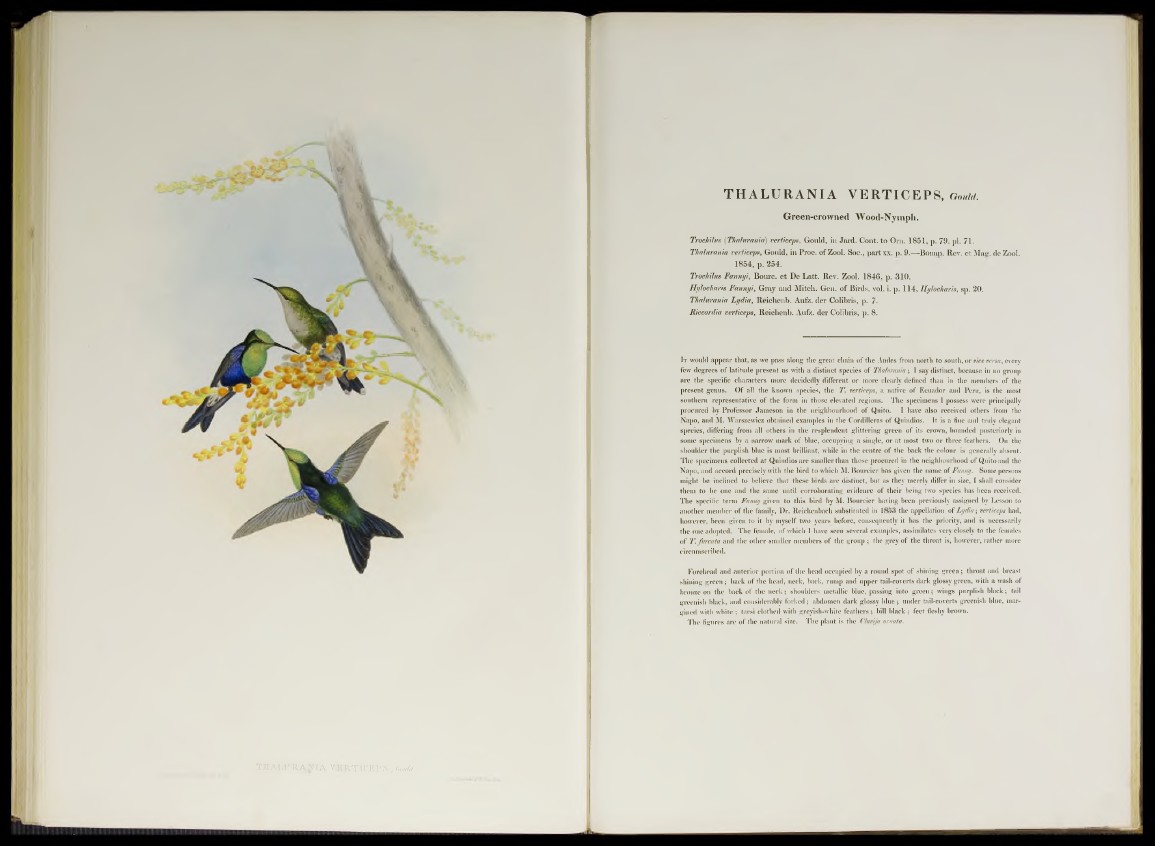
TH A L ITR AN IA VBR.TICJEPS»Gould.
THALURANIA YERTICEPS, Gould.
Green-crowned Wood-Nymph.
Trochilus (Thalurania) verticeps, Gould, in Jard. Cont. to Om. 1851, p. 79. pl. 71.
Thalurania verticeps, Gould, inProc. of Zool. Soc., partxx. p. 9.—Bonap. Rev. et Mae. de Zool.
1854, p. 254.
Trochilus Fannyi, Bourc. et De Latt. Rev. Zool. 1846, p. 310.
Hylocharis Fannyi, Gray and Miteh. Gen. of Birds, vol. i. p. 114, Hylocharis, sp. 20.
Thalurania Lydia, Reichenb. Aufz. der Colibris, p. 7.
Riccordia verticeps, Reichenb. Aufz. der Colibris, p. 8 .
It would appear that, as we pass along the great chain of the Andes from north to south, or vice versa, every
few degrees of latitude present us with a distinct species of Thalurania; I say distinct, because in no group
are the specific characters more decidedly different or more clearly defined than in the members of the
present genus. Of all the known species, the T. verticeps, a native of Ecuador and Peru, is the most
Southern representative of the form in those elevated regions. The specimens I possess were principally
procured by Professor Jameson in the neighbourhood of Quito. I have also received others from the
Napo, and M. Warszewicz obtained examples in the Cordilleras of Quindios. It is a fine and truly elegant
species, differing from all others in the resplendent glittering green of its crown, bounded posteriorly in
some specimens by a narrow mark of blue, occupying a single, or at most two or three feathers. On the
shoulder the purplish blue is most brilliant, while in the centre of the back the colour is generally absent.
The specimens collected at Quindios are smaller than those procured in the neighbourhood of Quito and the
Napo, and accord precisely with the bird to which M. Bourcier has given the name of Fanny. Some persons
might be inclined to believe that these birds are distinct, hut as they merely differ in size, I shall consider
them to be one and the same until corroborating evidence of their being two species has been received.
The specific term Fanny given to this bird by M. Bourcier having been previously assigned by Lesson to
another member of the family, Dr. Reichenbach substituted in 1853 the appellation of Lydia; verticeps had,
however, been given to it by myself two years before, consequently it has the priority, and is necessarily
the one adopted. The female, of which I have seen several examples, assimilates very closely to the females
of T. furcata and the other smaller members of the group ; the grey of the throat is, however, rather more
circumscribed.
Forehead and anterior portion of the head occupied by a round spot of shining green; throat and breast
shining green; back of the head, neck, back, rump and upper tail-coverts dark glossy green, with a wash of
bronze on the back of the neck; shoulders metallic blue, passing into green; wings purplish black; tail
greenish black, and considerably forked; abdomen dark glossy blue ; under tail-coverts greenish blue, mar-
gined with white ; tarsi clothed with greyish-white feathers; bill black ; feet fleshy brown.
The figures are of the natural size. The plant is the Clavija ornata.